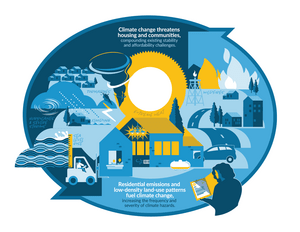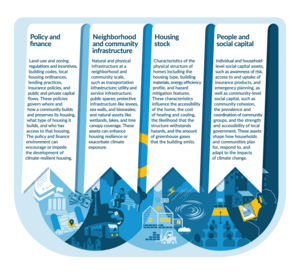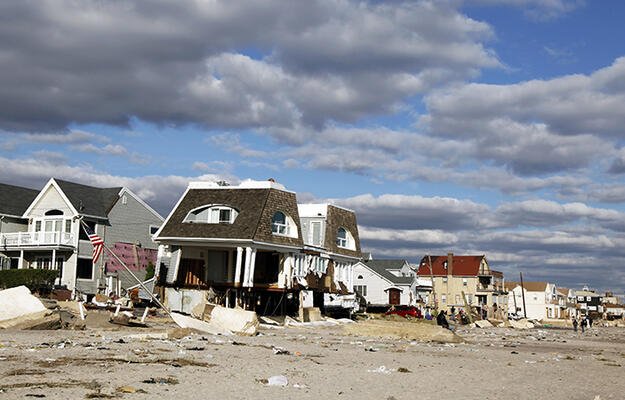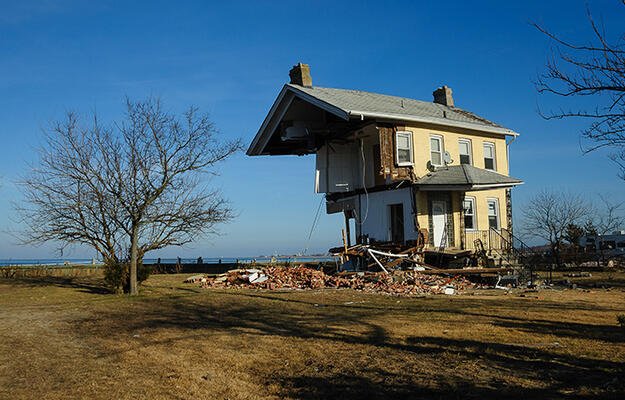
The Benefits of Climate-Resilient Housing
There’s an urgent need to transform our nation’s housing stock to reduce its carbon footprint and make it more climate resilient. Residential energy use and low-density land-use patterns contribute significant emissions that fuel planetary warming and make climate hazards more threatening. These climate hazards reduce housing supply and affordability, burdening residents with the financial and social costs of damage, recovery, and displacement.
Climate and Housing Intersections

The passage of major federal legislation like the Inflation Reduction Act and the Infrastructure Investment and Jobs Act provides planners, policymakers, developers, and advocates with an unprecedented opportunity to leverage the policy and economic context to improve the resilience and sustainability of the country’s affordable housing stock. In a new report, we present a holistic framework to assess the challenges and opportunities to advance climate-resilient housing across four key pillars of housing resilience: policy and finance, neighborhood and community infrastructure, housing stock, and people and social capital.
The Four Pillars of Housing Resilience

To date, progress on building climate resilience into the housing market has been hampered by siloes across stakeholders with different priorities, capacities, and understanding of challenges, opportunities, and resources. Among affordable housing practitioners, climate-related initiatives are often “nice to have”—late-stage considerations in tension with housing affordability priorities—rather than critical components of the housing’s long-term affordability and viability. Climate-focused changemakers rarely focus on housing, and when they do, efforts are most often siloed and geared toward sustainability or postdisaster mitigation rather than proactive, integrated solutions that address both sustainability and resilience goals.
Though they may add complexity and strain in the short term, new federal and state investments in climate provide a unique opportunity for the housing sector to engage with climate actors to access these funds and better integrate climate considerations into the housing market, especially for affordable units. To do so, actors across sectors need shared language, knowledge, and resources to better understand the emerging climate challenges and opportunities faced by the housing sector and advance holistic solutions that can address mitigation, adaptation, and environmental justice goals together.
By using an integrated, pillared approach, stakeholders can achieve multiple crosscutting outcomes, outlined below.
- Connect oftentimes-siloed housing actors and sectors. Navigating new collaborations and ways of planning, designing, developing, and financing climate-resilient housing will require those involved to be proactive, adaptable, and willing to break from the status quo. To support needed coordination, local governments can work with area housing actors and community stakeholders to convene resilient housing coalitions aligned with their unique characteristics and housing resilience goals. Local leaders can use the framework to identify relevant stakeholder groups across the four pillars, investigate their priorities and motivations for change, and leverage incentives, like the influx of federal resources, to bring priority stakeholders to the table to collaborate.
- Unlock the value of cobenefits. Building a more climate-resilient housing market can result in numerous benefits, including mitigating disaster impacts on housing, reducing greenhouse gas emissions, promoting housing stability and affordability, protecting financial health and wealth, and improving community health and well-being. In the era of heightened climate risk, this more holistic approach to planning and development is essential to protecting the durability of affordable housing investments and ensuring they result in long-term stability for families and communities. And by recognizing the expansive benefits of climate resilience, coalition groups can unlock access to new funding streams and deliver better outcomes for residents. For example, by highlighting the health benefits of sustainability and resilience retrofits, projects can attract funding from health and hospital systems or from philanthropic investors interested in supporting community health and wellness.
- Break the cycle of reactionary policy and develop proactive, long-term strategies. The orientation of most federal disaster-relief funding—and therefore, most resources for mitigation and planning—emerge during crises. But the new influx of resources presents an unprecedented opportunity to help shift from postdisaster response and recovery to a continuous, forward-looking approach. To support this transition, policymakers, planners, housers, and stakeholders can use the holistic, pillared approach to integrate resilience considerations into all aspects of planning, development, financing, and policymaking and adopt a “fast and slow” approach to prepare for the unique opportunities that arise during both times of stability and disaster response and recovery.
To start building more holistic and collaborative efforts to advance climate-resilience in their housing market, stakeholders can explore the series of foundational questions we outline in the report. These questions can help assess current and future climate risks in communities, map relevant stakeholders and stakeholders’ interest in housing affordability and climate resilience in a market, and identify the challenges and opportunities to advance climate-resilient housing across four key pillars of housing resilience: policy and finance, neighborhood and community infrastructure, housing stock, and people and social capital.
To learn more about our climate-resilient housing framework, explore the full report here.


